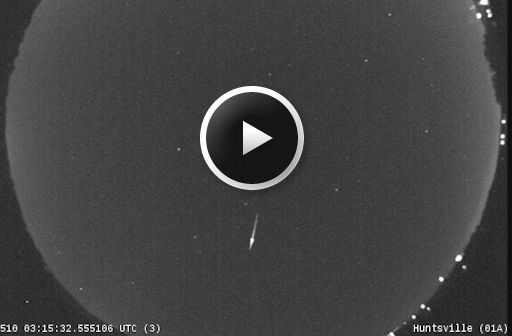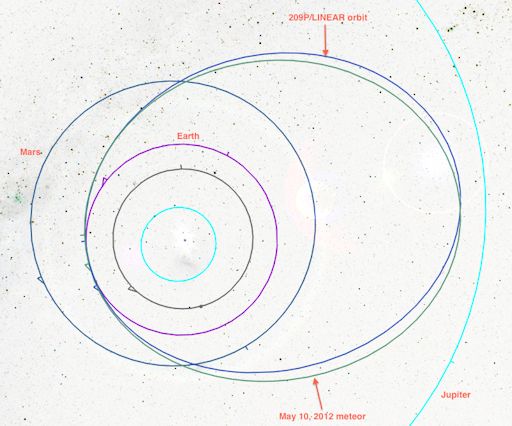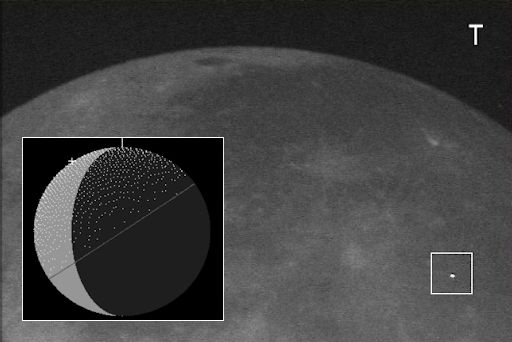When is the best time to see auroras? Where is the best place to go? And how do you photograph them? These questions and more are answered in a new book, Northern Lights - a Guide, by Pal Brekke & Fredrik Broms. | | |
GEOMAGNETIC ACTIVITY: A mild geomagnetic storm is underway around the poles on May 23rd as Earth travels through the wake of a minor CME. High-latitude sky watchers should be alert for auroras during tonight's meteor shower. Aurora alerts: text, voice
ANTICIPATION BUILDS FOR TONIGHT'S METEOR SHOWER: This weekend, Earth will pass through a stream of debris from Comet 209P/LINEAR. If forecasters are correct, the encounter could produce an outburst of bright meteors numbering more than 200 per hour. Most models agree that peak rates should occur between the hours of 0600 UT and 0800 UT (2 a.m. and 4 a.m. EDT) on Saturday morning, May 24th, a time frame that favors observers in North America. It is worth noting, however, that Earth has never encountered this stream of debris before, so forecasters cannot be certain of their predictions. The display could be a complete dud, a fantastic "meteor storm," or anything in between. Whatever happens, NASA plans to chat about it.
It is often said that this is a new shower, and no one has ever seen a Camelopardalid meteor before. Well...maybe just one. "We searched through our database of several thousand bright meteors and found a likely candidate," reports Bill Cooke of NASA's Meteoroid Environment Office. "Back on May 9th of 2012, one of our all-sky cameras caught it burning up at an altitude of 66 kilometers." This is what it looked like:

"Peaking at a magnitude of -2 (Mars brightness), our now-extinct visitor was about 3.3 cm in diameter - a little smaller than a ping pong ball," continues Cooke. "We believe it was a May Camelopardalid because it had an orbit that greatly resembles that of parent Comet 209P/LINEAR." The diagram, below, shows the match:

"So why is this good?" asks Cooke. "Looking back to 2012, our computer models show very little comet debris near Earth. We predicted nothing, yet got one meteor. Does this mean that a legion of his siblings will show up this year, when the models suggest the potential of a full-fledged meteor outburst? I'm getting excited about Friday night/Saturday morning."
Earth won't be the only body passing through the debris zone. The Moon will be, too. Meteoroids hitting the lunar surface could produce explosions visible through backyard telescopes on Earth. The inset in this picture of an actual lunar meteor shows the region of the crescent Moon on May 24th that could be pelted by May Camelopardalids:

According to NASA's Meteoroid Environment Office, the best time for amateur astronomers to scan the Moon for lunar meteors is after 0800 UT (4 a.m. EDT) on May 24th.
There is much uncertainty about the strength of this shower, both on Earth and on the Moon. As far as we know, our planet has never passed directly through a debris stream from Comet 209P/LINEAR, so no one knows exactly how much comet dust lies ahead. A magnificent meteor shower could erupt, with streaks of light in terrestrial skies and sparkling explosions on the Moon--or it could be a complete dud. Stay tuned!
Realtime Meteor Photo Gallery
[listen: meteor radar]
Realtime Space Weather Photo Gallery
Realtime Aurora Photo Gallery
Realtime Mars Photo Gallery
Realtime Comet Photo Gallery
Every night, a network of NASA all-sky cameras scans the skies above the United States for meteoritic fireballs. Automated software maintained by NASA's Meteoroid Environment Office calculates their orbits, velocity, penetration depth in Earth's atmosphere and many other characteristics. Daily results are presented here on Spaceweather.com.
On May. 23, 2014, the network reported 8 fireballs.
( 8 sporadics)

In this diagram of the inner solar system, all of the fireball orbits intersect at a single point--Earth. The orbits are color-coded by velocity, from slow (red) to fast (blue). [Larger image] [movies]
Potentially Hazardous Asteroids (
PHAs) are space rocks larger than approximately 100m that can come closer to Earth than 0.05 AU. None of the known PHAs is on a collision course with our planet, although astronomers are finding
new ones all the time.
On May 23, 2014 there were 1476 potentially hazardous asteroids.
Notes: LD means "Lunar Distance." 1 LD = 384,401 km, the distance between Earth and the Moon. 1 LD also equals 0.00256 AU. MAG is the visual magnitude of the asteroid on the date of closest approach. | | The official U.S. government space weather bureau |
| | The first place to look for information about sundogs, pillars, rainbows and related phenomena. |
| | Researchers call it a "Hubble for the sun." SDO is the most advanced solar observatory ever. |
| | 3D views of the sun from NASA's Solar and Terrestrial Relations Observatory |
| | Realtime and archival images of the Sun from SOHO. |
| | from the NOAA Space Environment Center |
| | the underlying science of space weather |

